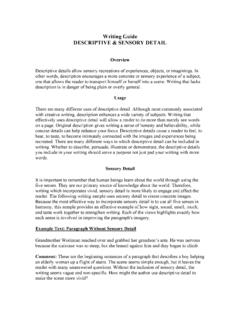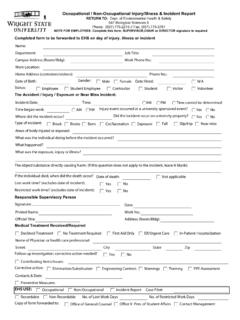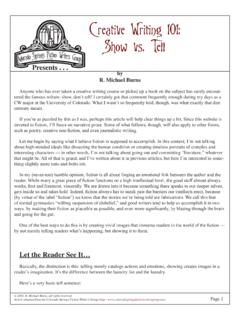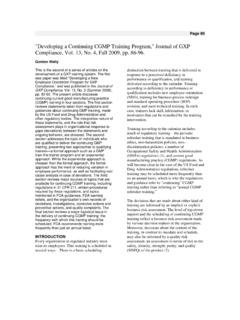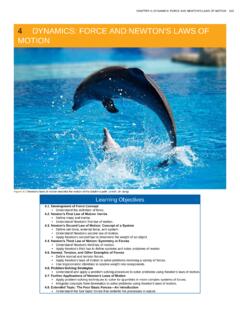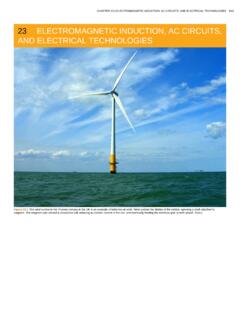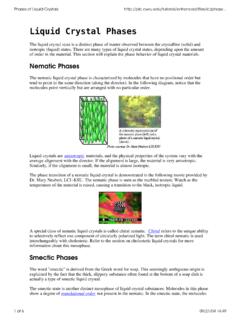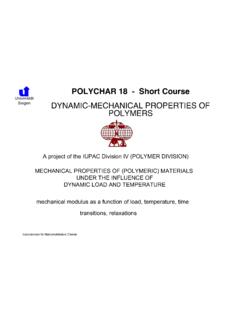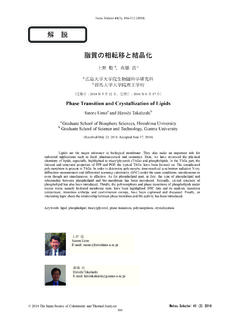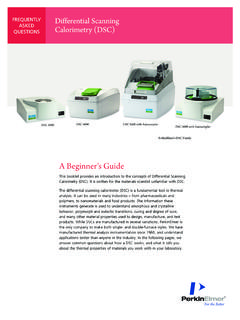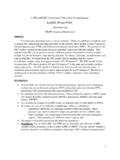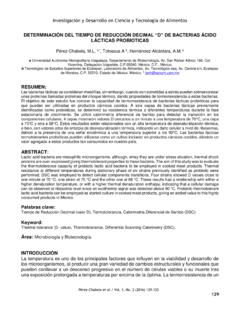Transcription of Lecture: Microstructures in Polymers
1 Textbook: Plastics: Materials and Processing (Third Edition), by A. Brent Young (Pearson, NJ, 2006).Structure and Properties of Engineering PolymersLecture: Microstructures in PolymersNikolai V. PriezjevMicrostructures in Polymers Gas, liquid, and solid phases , crystalline vs. amorphous structure, viscosity Thermal expansion and heat distortion temperature Glass transition temperature, melting temperature, crystallization polymer degradation, aging phenomena Molecular weight distribution, polydispersityindex, degree of polymerization Effects of molecular weight, dispersity, branching on mechanical properties Melt index, shape (steric) effectsReading: Chapter 3 of Plastics: Materials and Processingby A.
2 Brent , Liquid and Solid PhasesIncreasing densityAt room temperatureSolid or liquid?Pitch Drop , before and after being hit with a 1927, Professor Parnell at UQ heated a sample of pitch and poured it into a glass funnel with a sealed stem. Three years were allowed for the pitch to settle, and in 1930 the sealed stem was cut. From that date on the pitch has slowly dripped out of the funnel, with seven drops falling between 1930 and 1988, at an average of one drop every eight years. However, the eight drop in 2000 and the ninth drop in 2014 both took about 13 years to fall.
3 It turns out to be about 100 billion times more viscous than water!Pitch (derivative of tar) at room T feels like solid and can be shattered by a hammer. But, the longest experiment shows that it flows!Liquid phases : polymer melt vs. polymer solutionSemi-dilute solution:Dilute solution: polymer melt:Chains in solvent do not overlap:--Can consider that each polymer chain acts in semi-dilute solutions concentration of polymer chains is sufficient for chains to just solvent/only polymer chainsReptation motion of long linear, entangled macromolecules amorphous viscosityLow viscosityT up, viscosity downLiquid Crystal phases Isotropic phaseNematic phase Smectic A Liquid crystal displays:OFF stateON stateNo positional butorientational order!
4 DirectorStiff backbone Crystal Polymers Characteristics: These are a class of aromatic polymer . Extremely unreactive and inert. Highly resistant to nematic liquid crystalsKevlar, the most widely used body armor is made up of intertwined liquid crystal or more monomer polymerized together random A and B randomly vary in chain alternating A and B alternate in polymer chain block large blocks of A alternate with large blocks of B graft chains of B grafted on to A backboneA B Copolymer MicrostructuresaLamella structure. bDouble gyroid (bicontinuous) structure.
5 CCylindrical dispersion structure. dSpherical dispersion structure.(Di) Block Copolymer MicrostructuresBlock copolymer Microstructures and the phase diagram for the polystyrene-polyisoprene diblock copolymer system. The metastable perforated lamellar microstructure is illustrated in the upper right corner of the phase , the relative volume fractions of the dissimilarsegmentsN, molecular weight Structure and order in soft matter: symmetry transcending length scale. Ward and Horner CrystEngComm, 2004, 6, 401-407 Triblock Terpolymers Tri-block terpolymers may be thought of simply as a diblock copolymer (AB) upon which a third block (C) is CrystallinityCrystallization in linear Polymers .
6 Achieving a very regular arrangement of the mersInduction of crystallinity cooling of molten polymer evaporation of polymer solution annealing heating of polymer at a specific temperature drawing stretching at a temperature above Tg Increased Density Increases Stiffness (modulus) Reduces permeability Increases chemical resistance Reduces toughnessEffects of crystallinity:Semi- CrystallinityCrystalline morphologies Spherulite aggregates of small fibrils in a radial pattern (crystallization under no stress) Drawn fibrillar obtained by drawing the spherulitic fibrils Epitaxial one crystallite grown on another; lamella growth on long fibrils.
7 The so-called shish-kebab morphology (crystallization under stirring)Crystalline Polymers (vs amorphous Polymers ) tougher, stiffer(due to stronger interactions) higher density, higher solvent resistance(due to closely packing morphology) more opaque(due to light scattering by crystallites)Thermal Expansion and Heat Distortion TemperatureAromatic content, crosslink density, crystallinity, secondary bonding can raise T at which distortion occurs. Test apparatus (dilatometer) used for measuring the coefficient of thermal expansion (CTE=size/C).
8 Deflection Under Loadtest to determine heat distortion temperature(HDT). Test time: ~10,000 hours!Changes in length compared to original length ( / 0) called linear Glass transition Temperature, Tg The glass transition , Tg, is temp. below which a polymer OR glass is brittle or glass-like; above that temperature the material is more plastic. The Tgto a first approximation is a measure of the strength of the secondary bonds between chains in a polymer ; the stronger the secondary bonds; the higher the glass transition Tg= 0 C; Polystyrene = 97 CPMMA (plexiglass) = 105 room temp.
9 Is < Tgfor PMMA, it is brittle at room rubber bands: Tg= -73 and second-order phase transitions (I)The classification of phase transitions proposed by Ehrenfest is based on the behavior of G near the phase phase transition : first derivatives of G are phase transition : first derivatives of G arecontinuous, but second derivatives of G are = H -TSFirst-order and second-order phase transitions (II)First-order phase transition : first derivatives of G are phase transition : first derivatives of G arecontinuous, but second derivatives of G are = H -TSThe Glass transition Temperature, TgGlass transition temperature of a polymer is the temperature at which there is enough thermal energy for the polymer chains to move freely (wiggle around).
10 differential scanning calorimetry (DSC) methodThermomechanical analysis (TMA) = volume expansionDynamic Mechanical Analysis(DMA): response to oscillatory shearGlass transition and Melting Point for ThermoplasticsGlass transition and Melting Properties of Selected temperature, Tm: Influence of that affect the glass transition temperature, TgMolecular WeightAdapted from A. Abou Elfadl et al. From Rouse to Fully Established Entanglement Dynamics: A Study of Polyisoprene by Dielectric Spectroscopy 2010 Macromolecules, 43, Fox equation PolyisopreneBackbone FlexibilityPendant GroupsThis backbone is so flexible that polydimethylsiloxane has Tg way down at -127oC!

